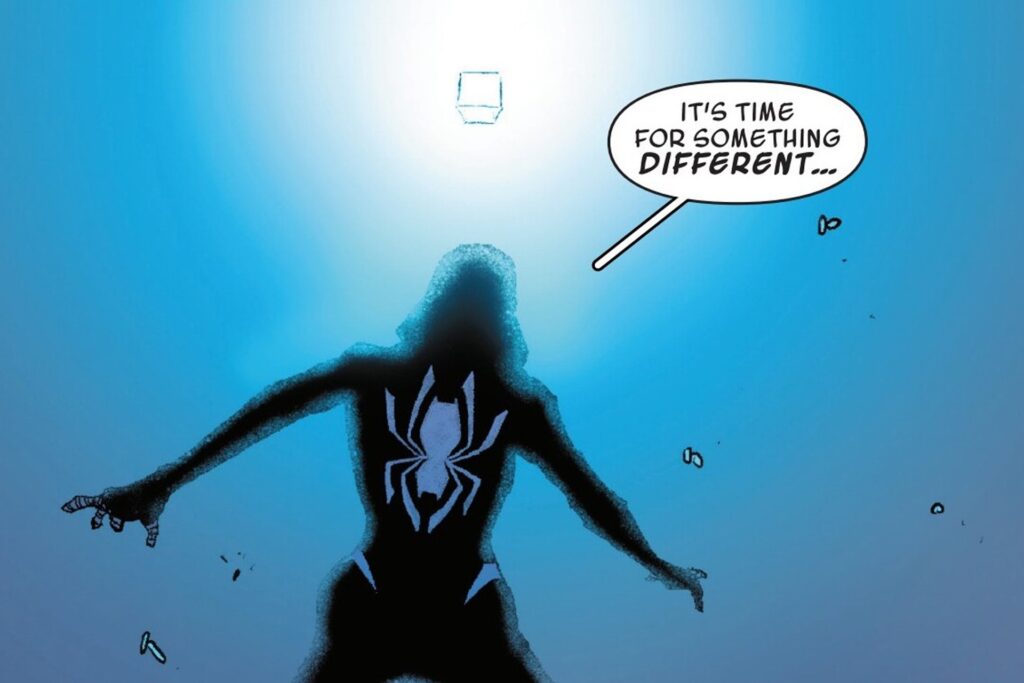
Marvel Comics has once again stirred the pot with a bold move that sees one of its beloved characters, Spider-Gwen, undergo a significant transformation. The latest issue of Spider-Gwen: Ghost Spider concluded this week, paving the way for an “All-New” relaunch next month. This shift has left fans both intrigued and bewildered as the character’s narrative takes a new direction.
In the concluding issue, penned by Stephanie Phillips with art by Von Randal and Matt Milla, Gwen Stacy finds herself in a precarious situation. Having left her original home, Earth-65, due to a confrontation with King Loki over a Cosmic Cube, Gwen is now residing in Marvel’s prime reality, Earth-616. This transition is not just geographical; it involves a profound change in her powers and personal history.
The Cosmic Cube Conundrum
During her battle with King Loki, Gwen inadvertently fuses with the Cosmic Cube, a powerful relic capable of altering reality. This fusion leads to a climactic showdown where Gwen, after a mindscape conversation with the Cube, decides to rewrite her fate. In an unexpected twist, she defeats Loki, leading to his arrest by the Time Variance Authority (TVA), and saves her rival-turned-love interest, Fabian LaMuerto, from death.
However, Gwen’s decision to use the Cube’s powers is not just about victory over Loki. It marks a new beginning for her, as she separates from the Cube and awakens in Earth-616 with her original powers restored. This change is significant, considering she had been bonded with symbiote powers for nearly a decade.
A New Status Quo
The implications of Gwen’s new reality extend beyond her powers. Her father, Captain George Stacy, is now alive and well in Earth-616, a stark contrast to his long-dead counterpart in this universe. This resurrection raises questions about the continuity and the nature of reality in Marvel’s multiverse.
Marvel’s decision to align Spider-Gwen’s story with a more familiar version known from the Spider-Verse films reflects a broader trend of synergy between comics and their cinematic adaptations. This move, however, comes at the cost of erasing part of her identity as a character from a separate reality.
Historical Parallels and Future Implications
This isn’t the first time Marvel has reimagined its characters in such a way. The transition of Miles Morales from the Ultimate Universe to Earth-616 during Secret Wars is a notable precedent. Like Spider-Gwen, Miles’ integration raised questions about existing counterparts and continuity.
According to comic book historian Dr. Emily Carter, “Marvel’s strategy often involves reconfiguring characters to align with their cinematic portrayals. This not only broadens their appeal but also keeps the comic narratives fresh and engaging.”
“Status quos are ephemeral in comics; when death is a revolving door, it’s hard to ever really definitively say what will be a ‘new normal’ for longer than a few years.” – Dr. Emily Carter
Looking ahead, the upcoming relaunch of Spider-Gwen: Ghost Spider is being marketed as her “Brand New Day.” This could potentially set the stage for further developments in the Marvel Cinematic Universe (MCU), especially as the MCU’s Peter Parker approaches his own pivotal moments.
Conclusion
As fans eagerly await the next chapter in Spider-Gwen’s journey, questions linger about the long-term impact of these changes. Will Gwen remain in Earth-616, or could she eventually return to her original reality? Only time will tell how this bold narrative shift will play out in the broader Marvel universe.
For now, Marvel’s decision to realign Spider-Gwen’s story reflects both a nod to her cinematic popularity and a willingness to experiment with the fluid nature of comic book storytelling. As the new series launches, readers will be watching closely to see how these changes unfold and what they mean for the character’s future.






